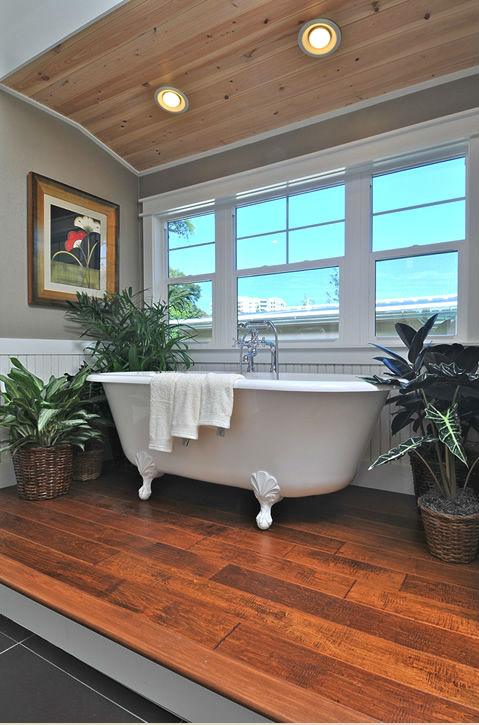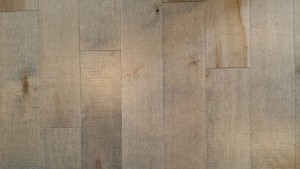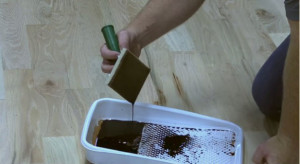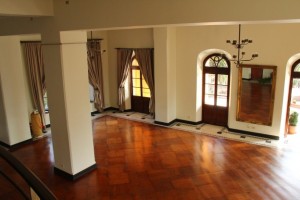What do homeowners want? Do they prefer wide planks? Dark stains? Exotic species? Or are they sticking with more conventional floors?
Ultimately, it depends on the individual homeowner’s unique preferences and the specific market that the contractor serves.
Still, there are a few hardwood flooring trends that seem to be universally on the rise in the residential market, so be on the lookout this summer for the following requests from clients.
Wide plank flooring is in
Wide plank flooring is on the upswing in residential and commercial markets alike.
“2-¼-inch flooring was a contractor’s bread and butter up until 10 years ago,” says Jim Gourniak of East Penn Hardwood Flooring. But now, he says, nearly every site-sanded request he gets is at least 3-¼” wide. It seems that 2-¼” floors are increasingly becoming a thing of the past.
Most of the other contractors we spoke to confirmed this upswing in the popularity of wide plank flooring.
Never worked with wide planks before? Read our tips for wide plank hardwood flooring installs.
Why the surge in popularity of wide plank floors?
For some, wider planks are visually appealing. They give a room the appearance of added depth, so they’re good to install in a small room or open floorplan to make the space look bigger.
They’ve also got a rustic appeal. Before commercial mills became popular, most hardwood floors were wide plank by default.
Demand for rustic look = demand for handscraped, distressed hardwood floors
Sometimes, grunge is good.
Uncorrectable mistakes are a contractor’s worst nightmare, but that’s not so when it comes to handscraped and distressed flooring, where damage is not just the norm––it’s ideal.
Some homeowners buying recently built houses want to replicate the look of old, worn-down flooring. This calls for distressed or handscraped flooring to create the appearance of damage to the floors.

Handscraping and distressing techniques include denting, sanding, and scooping the wood to create the appearance of abrasive damage and more subtle damage, like worm holes.
Jim Gourniak says that prefinished handscraped floors have become more affordable in recent years, which has also contributed to the popularity of this type of flooring.
You’ll hear the terms “handscraped” and “distressed” thrown around a lot, sometimes even within the same sentence. But they mean different things. The marks on distressed flooring are usually created by a machine using a wire brush. But with handscraped flooring, as the name suggests, the marks are created by hand.
Not only are these floors visually appealing because of their rustic look, but they can be practical. A lot of homeowners select handscraped or distressed floors for spaces where the floors might sustain a lot of damage. Any further damage to the wood would likely blend into the design.
Some handscraped patterns are created at the mill, while a number of contractors do handscraping onsite.
When planks are handscraped onsite, clients have the power to decide exactly how much and what kind of “damage” they want done to their floors, leading to a completely customized look.
Prefinished vs. Unfinished? It depends on the setting and neighborhood
People living in condos and apartments might face restrictions on site sanding, forcing them to go with prefinished hardwood floors.

Jim Gourniak says that people who want to occupy their homes while the floors are installed
usually go with prefinished floors to avoid an impact on their indoor air quality.
Prefinished floor installations are also much quicker, which allows homeowners to start using their floors again practically right away. UV floor curing is also good for cases where homeowners don’t want much downtime, because the floors cure instantly.
Homeowners with existing wood floors usually go with site-finished installations to match the floors in rest of home, according to Jim Gourniak.
Site-finished floors are also much more popular with those who want to create unique looks with stains, paints, and the like because they are much more customizable than prefinished floors. (Read more about prefinished vs. unfinished hardwood floors.)
Stains and species
In many markets, homeowners still prefer to have traditional, site-sanded white oak floors installed in their homes, according to the contractors we spoke with.
Ed Coyle of Coyle Hardwood Flooring says that white oak and red oak comprise about 80 percent of his installations.

Oak has always been the main species choice of American homeowners due to the sheer availability of the wood.
But what holds some people back from going out on a limb and getting a completely customized floor is the need to match other homes in their neighborhood to maintain a good resale value for their houses.
Homeowners have to keep in mind the general look of homes in their neighborhood and try to match them in order to increase their chances of selling their house in the future, says Jim Gourniak.
Jim says that in his market, people tend to stick with solid, quarter-sawn white oak floors because that’s what’s most people in the neighborhood have in their homes.
If someone were to install handscraped, wide-plank, prefinished Brazilian cherry in a neighborhood filled with polyurethane-finished, quarter-sawn 3-¼” white oak floors, they might experience a bit of a problem when it came time to resell.
According to Andrew Sosnowsky of ARS Hardwood, for a lot of people, the selection of traditional wood is often due to price point, while other homeowners are simply concerned with matching the floors in the rest of the home.
The seeming preference for oak is also a matter of taste––sometimes people just prefer the traditional look of a site-sanded, polyurethane-finished oak floor.
What about exotics? Jim says that exotic species took a downturn a couple of years ago, but recently they’re making a comeback in his market. However, he says that bamboo has dropped off the charts within the past two years. Alongside the comeback of exotics and the prevalence of white oak, Jim is seeing an upswing in the popularity of hickory.
As for stain preferences, it depends on the type of client. Ryan Lescher of Jim Zane Carpentry and Bob Rhoads of Robert Rhoads Hardwood Floors and More both say that darker stains are becoming more popular in their respective markets.
In certain neighborhoods, people love darker stains, while in bordering neighborhoods the mainstay might still be white oak.
Ultimately, the popularity of certain hardwood floor trends will depend on your market.
Different people have different tastes, so it follows that clients in different markets will prefer completely different styles of hardwood flooring.

Andrew Sosnowsky says that a lot of customers want the contractor to decide what’s best for their house. That puts added responsibility on the contractor––not only are you expected to do a good job on the installation, but you’re also expected to do a bit of interior designing.
How do you do this effectively?
“Contractors have to market themselves,” says Andrew. Find out about the trends in the neighborhoods you serve and those you want to serve. Gauge your prospects’ interest in certain species, colors, finish types, and widths.
Observe what your current clients tend to go with, and see if there are any changes from neighborhood to neighborhood. This will help you market your services better because when you propose to new prospects, you’ll be telling the right things to a receptive audience.
Think about how many more sales you can get from better understanding your target audience’s preferences and predispositions. It’s easier to craft proposals and close deals when you have an idea about what your prospects would like to have in their homes.
Staying on top of the latest hardwood flooring trends is also an important part of marketing yourself effectively and closing more deals.
Sign up for Houzz to see what customers are sharing and talking about. Read Hardwood Floors Magazine, talk to other contractors in your area, and sign up for a FloorMasters account to connect with contractors around the country and see what’s trending in different areas.
Ultimately, it’s up to you to keep on top of the latest trends and market yourself to clients. “Educate yourself about what’s out there,” Andrew suggests.
